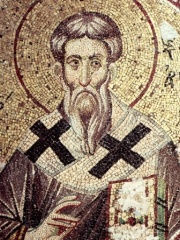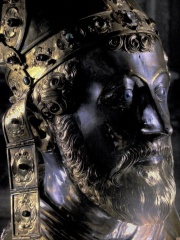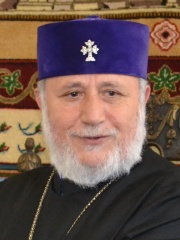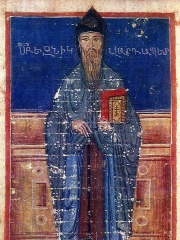



The Most Famous
RELIGIOUS FIGURES from Armenia
This page contains a list of the greatest Armenian Religious Figures. The pantheon dataset contains 3,187 Religious Figures, 5 of which were born in Armenia. This makes Armenia the birth place of the 63rd most number of Religious Figures behind Nepal, and Tunisia.
Top 5
The following people are considered by Pantheon to be the most legendary Armenian Religious Figures of all time. This list of famous Armenian Religious Figures is sorted by HPI (Historical Popularity Index), a metric that aggregates information on a biography's online popularity.

1. Gregory the Illuminator (257 - 331)
With an HPI of 75.23, Gregory the Illuminator is the most famous Armenian Religious Figure. His biography has been translated into 45 different languages on wikipedia.
Gregory the Illuminator (c. 257 – c. 331) was the founder and first official head of the Armenian Apostolic Church. He converted Armenia from Zoroastrianism to Christianity in the early fourth century (traditionally dated to 301), making Armenia the first state to adopt Christianity as its official religion. He is venerated as a saint in the Armenian Apostolic Church and in some other churches. Gregory is said to have been the son of a Parthian nobleman, Anak, who assassinated the Arsacid king of Armenia Khosrov II. The young Gregory was saved from the extermination of Anak's family and was raised as a Christian in Caesarea of Cappadocia, then part of the Roman Empire. Gregory returned to Armenia as an adult and entered the service of King Tiridates III, who had Gregory tortured after he refused to make a sacrifice to a pagan goddess. After discovering Gregory's true identity, Tiridates had him thrown into a deep pit well called Khor Virap for 14 years. Gregory was miraculously saved from death and released after many years with the help of Tiridates' sister Khosrovidukht. Gregory then converted the King to Christianity, and Armenia then became the first country to adopt Christianity as a state religion in 301 AD. Gregory, the Illuminator, then healed King Tiridates, who the hagiographical sources say had been driven mad by his sins, and preached Christianity in Armenia. He was consecrated bishop of Armenia at Caesarea, baptized King Tiridates and the Armenian people, and traveled throughout Armenia, destroying pagan temples and building churches in their place. Gregory eventually gave up the patriarchate to live as a hermit and was succeeded by his son Aristaces. Gregory's descendants, called the Gregorids, hereditarily held the office of Patriarch of Armenia with some interruptions until the fifth century. It is in Gregory's honor that the Armenian Church is sometimes called lusavorchakan ("of the Illuminator") or Gregorian.

2. Servatius of Tongeren (400 - 384)
With an HPI of 68.63, Servatius of Tongeren is the 2nd most famous Armenian Religious Figure. His biography has been translated into 25 different languages.
Saint Servatius (Dutch: Sint Servaas; French: Saint Servais; Limburgish: Sintervaos; died 13 May 384) was bishop of Tongeren (Latin: Atuatuca Tungrorum, the capital of the Tungri). Servatius is patron saint of the city of Maastricht and the towns of Schijndel and Grimbergen. He is one of the Ice Saints. His feast day is May 13.

3. Sebeos (700 - 700)
With an HPI of 66.22, Sebeos is the 3rd most famous Armenian Religious Figure. His biography has been translated into 28 different languages.
Sebeos (Old Armenian: Սեբէոս) was the author of a 7th-century Armenian history. Though his name is not known, he was likely a member of the clergy. It is the primary source for Armenian history in the 6th and 7th centuries. It is valued as the earliest surviving major account of the rise of Islam and the early Muslim conquests and as one of the very few non-Islamic sources on the Muslim conquests.

4. Karekin II (b. 1951)
With an HPI of 65.99, Karekin II is the 4th most famous Armenian Religious Figure. His biography has been translated into 32 different languages.
Catholicos Garegin II (Armenian: Գարեգին Բ, also spelled Karekin; born 21 August 1951) is the Catholicos of All Armenians, the supreme head of the Armenian Apostolic Church, since 1999. In 2013 he was unanimously elected the Oriental Orthodox head of the World Council of Churches for the next eight years.

5. Eznik of Kolb (380 - 450)
With an HPI of 59.74, Eznik of Kolb is the 5th most famous Armenian Religious Figure. His biography has been translated into 17 different languages.
Eznik of Kolb (Old Armenian: Եզնիկ Կողբացի, romanized: Eznik Kołbacʻi; c. 380 – 450) was an Armenian Christian writer of the 5th century. He was one of the students of Mesrop Mashtots, the inventor of the Armenian alphabet. His only surviving work is an untitled treatise which refutes various religious and philosophical ideas. Scholars refer to this work as Refutation of the Sects or On God. Travelling to Edessa and Constantinople, Eznik participated in the translation of the Bible and other Christian literature from Greek and Syriac into Armenian. He is believed to be identical with a bishop of Bagrevand named Eznik.
People
Pantheon has 5 people classified as Armenian religious figures born between 257 and 1951. Of these 5, 1 (20.00%) of them are still alive today. The most famous living Armenian religious figures include Karekin II. The most famous deceased Armenian religious figures include Gregory the Illuminator, Servatius of Tongeren, and Sebeos.
Living Armenian Religious Figures
Go to all RankingsDeceased Armenian Religious Figures
Go to all RankingsGregory the Illuminator
257 - 331
HPI: 75.23
Servatius of Tongeren
400 - 384
HPI: 68.63
Sebeos
700 - 700
HPI: 66.22
Eznik of Kolb
380 - 450
HPI: 59.74

